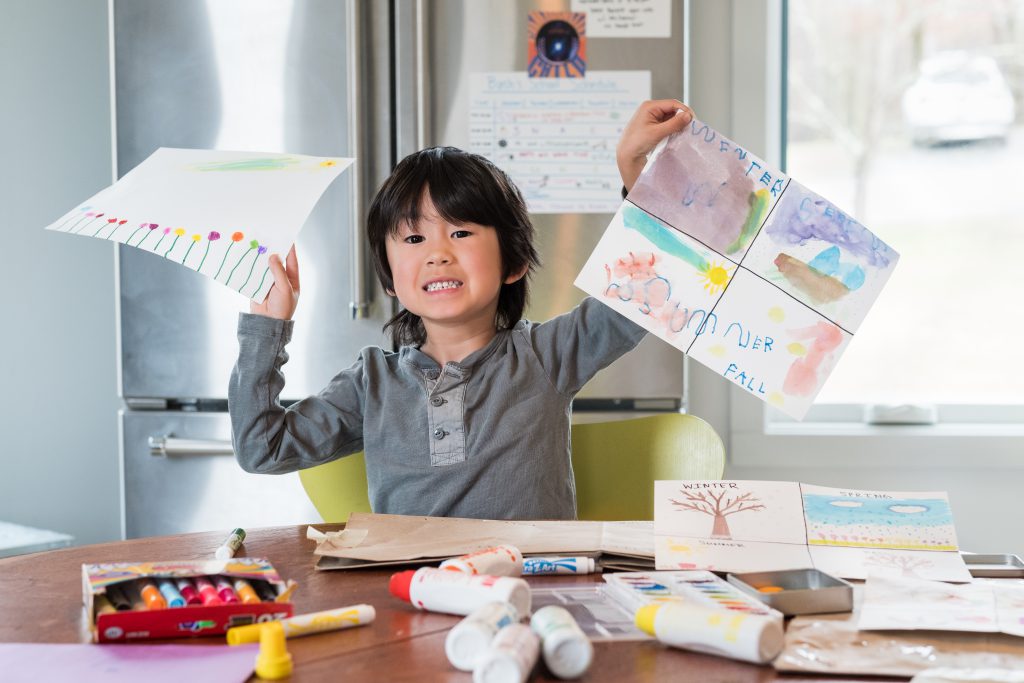
With Bash’s Pre-Kindergarten class returning virtually from Spring Break, we have been adjusting to “virtual learning” and certainly keeping busy. Our mornings are spent with an online meeting, followed by school-led activities covering early literacy, math, movement, Spanish, art, music, and greenhouse. After his school work is completed, we’ve been taking advantage of our backyard woods (very thankful for being up in the Catskills right now) and doing fun arts and crafts and STEM projects in the afternoons. This week, we focused on exploring Spring. Below are activities that Bash (5 yrs.) and Ava (2 yrs) enjoyed the most. Hope your little ones enjoy and let me know if you have additional fun Spring-themed activities! For additional ideas, check out our Spring Activities Pinterest Board.
Day 1: Introducing Spring and an Overview of The Seasons
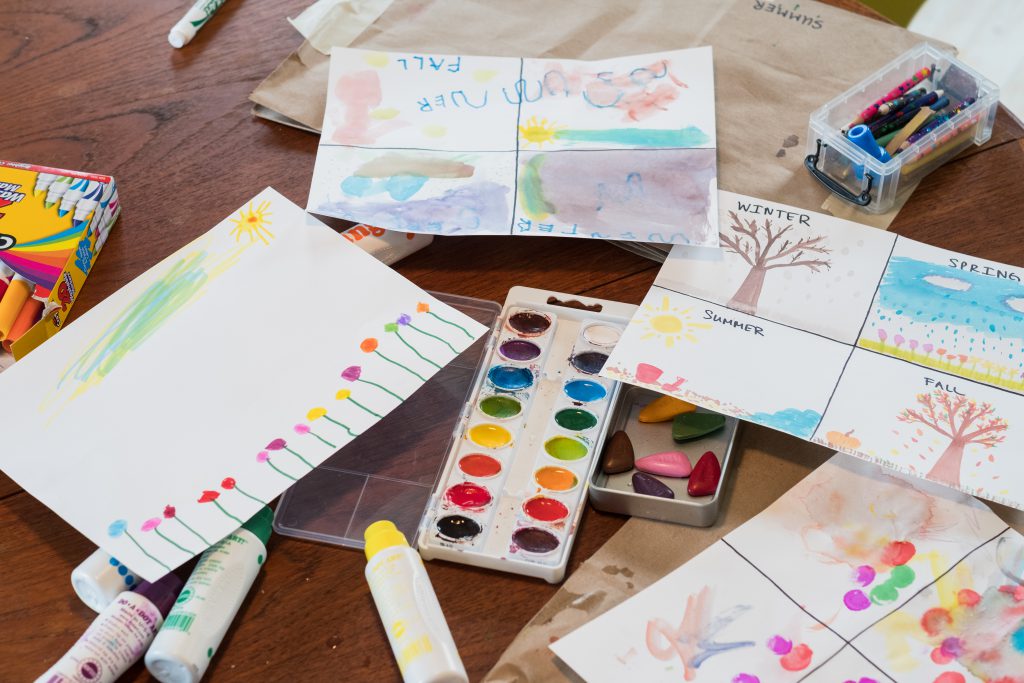
As we’ve been noticing our robin friends chirping in the yard and the forsythia suddenly exploding into giant neon fireworks, I wanted to seize the opportunity to teach Bash about the change of seasons and the passage of time. We kicked off our Spring theme by reviewing all the seasons which was a great transition from our previous week’s space theme. Bash really liked how we acted out seasonal change: Bash pretended he was the sun (and didn’t forget to remind me several times how he was “made of gas”, haha) and I acted as Earth, orbiting the sun and rotating at the same time. While not a perfect science, it was a great way to demonstrate the concepts of how we get closer to the sun (summer) and further away from the sun (winter) at various times of the year.
Videos
- Brain Pop Junior’s Seasons provides a nice, ~5 minute overview of the seasons. Bash really likes Annie and Moby and finds the information is simple and easy to grasp.
- Brain Pop Junior’s Spring is similar to the above Seasons video, providing a short introduction to Spring, typical weather, the habits and activities of animals, birds, insects, and people, and the lifecycle of plants and flowers. Overall, it’s a great springboard and inspiration for the remainder of our daily topics.
- Sci Show’s Spring Science video is a longer (~15 minutes) introduction to Spring. The host speaks on the quicker side, but there is some great information covered and Bash really enjoyed it.
- Pink Fong Spring Has Come Storytime: ~5 minute animated story about animals and insects waking for Spring.
Books
- Free video books from Scholastic Remote Learning’s Spring: And Then It’s Spring (video story) and How Do You Know Its Spring (read along)
- Everything Spring
- Goodbye Winter, Hello Spring
- Let’s Look at Spring
- When Spring Comes
- The Berenstain Bears Big Book of Science and Nature
Songs
- Have Fun Teaching Seasons Song (~4 minutes)
- Little Baby Bum Seasons Song (~2 minutes)
Activities
- Art: Draw / paint seasonal scenes:
- Make a picture of all four seasons. Fold a sheet of paper into quarters. In each quadrant, ask your child to spell and write the name of each season. Then draw / paint scenes depicting each of the four seasons.
- Draw / paint a scene depicting just Spring on a full sheet of paper.
- Mixed media spring flowers: Fold a sheet of paper in half landscape style. On the top half, have the child paint the sky with blue watercolor paint. On the bottom half, have them paint the grass with green watercolors. Once dry, have the child draw their spring scene with crayons.
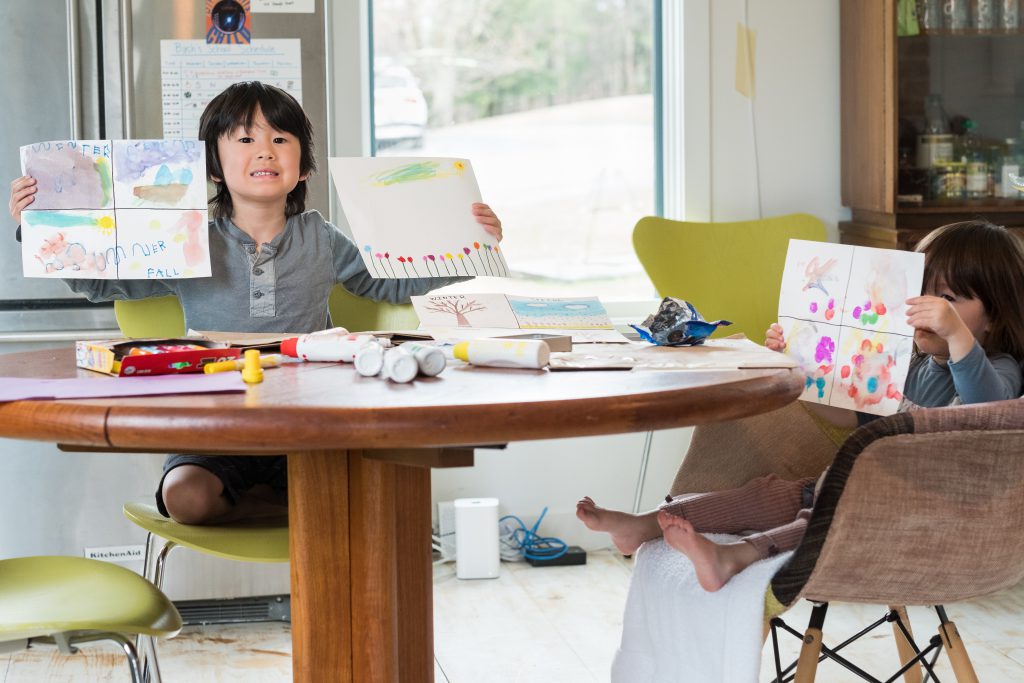
- Outdoors / movement activity: Spring scavenger hunt. Head outdoors and ask your child to find things representative of spring. If you have a printer, here’s a handy, free Spring Scav Hunt from TeachingMama.org. No printer, no problem: draw your own! Don’t forget to gather twigs, branches, leaves, rocks, etc. to serve as supplies for future activities. To extend the activity, ask your child to sort the found objects by texture (rough vs. smooth), size (long vs. short / big vs. small), color, weight, etc.
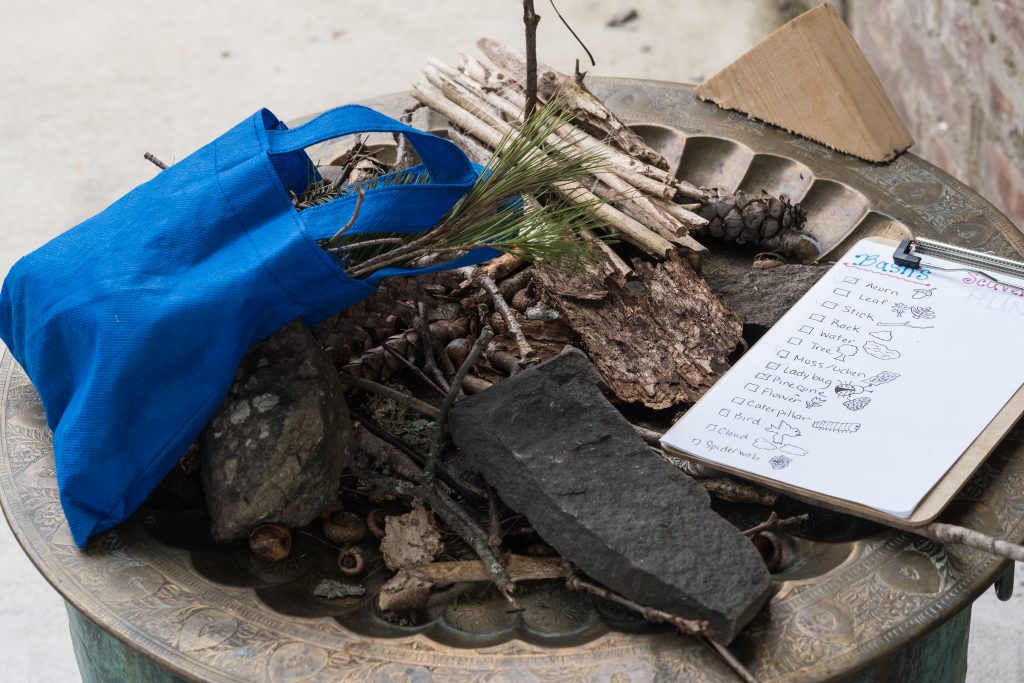
- Arts and crafts: Paint with nature using twigs and leaves (all the things you found during your scavenger hunt) to paint pictures instead of a brush.
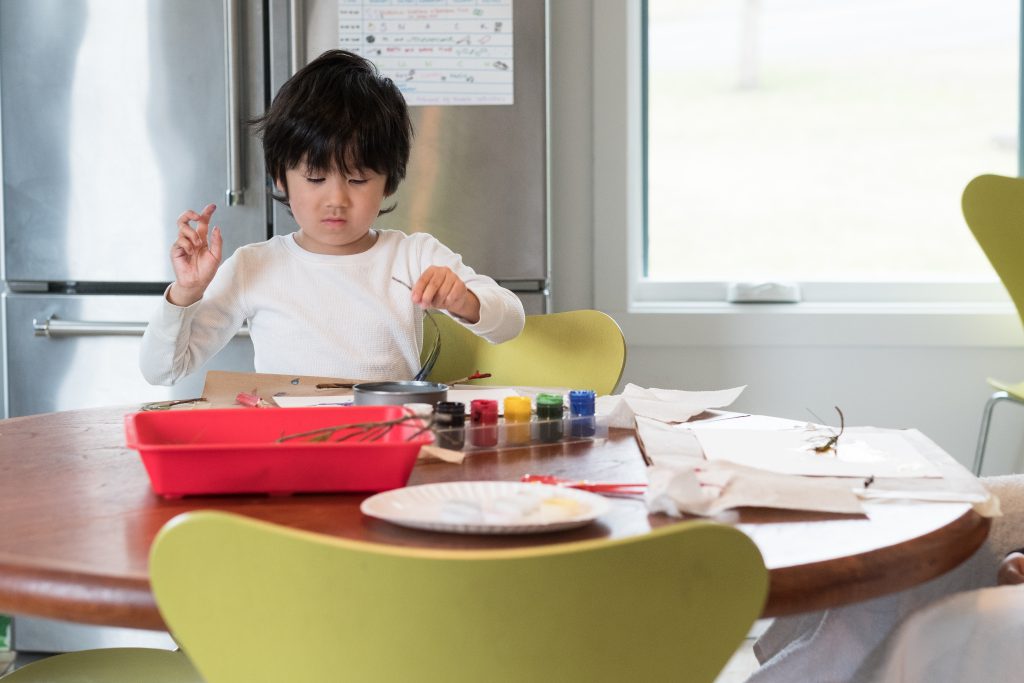
Additional Ideas and Resources
- Arts and crafts / letters: Spell out your child’s name using the natural objects you found during your scavenger hunt. MrsJonesCreationStation has a fun craft tutorial.
Day 2: Spring Weather
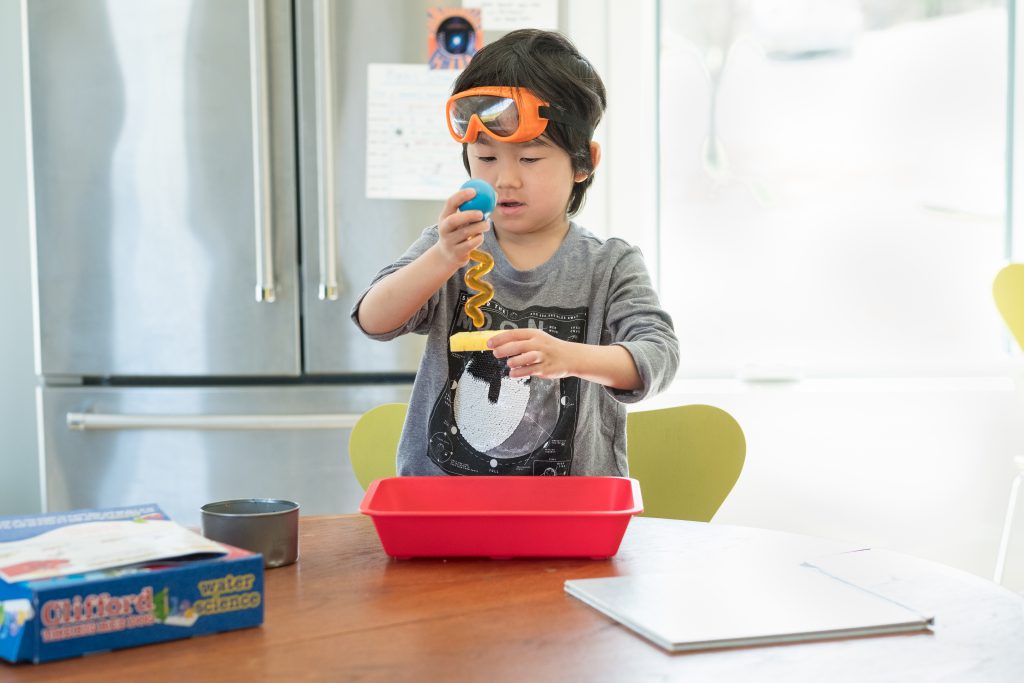
April showers bring May flowers! Today was dedicated to our typical spring, rainy weather.
Videos
- Mystery Science: Forecasting the Weather video and activity provides a nice introduction to typical weather patterns associated with each season.
- Mystery Science’s How is a rainbow made is a quick ~1 minute video about rainbows.
- Sid the Science Kid What are Clouds Made (~2 minutes) a quick clip about rain clouds that introduces some key weather vocabulary.
- National Geographic’s How is Rain Formed is a very brief clip showing the potentially destructive power of rain. I really wished it were longer and went into more detail, but Bash loved seeing the car get smashed.
- National Geographic’s Thunderstorms 101 (~3 minutes)
- NOVA Making of a Cloud (~3 minutes) is a simple introduction to the water cycle.
- NOVA Clouds and Weather (~3 minutes) is a nice addition to the above NOVA cloud video. The vocabulary is more sophisticated, but Bash understood the concepts about weather fronts with help from the simple graphics.
- PBS Secret Life of a Raindrop (~10 minutes) is way more advanced but still held Bash’s attention.
Books
- Free video books from Scholastic’s Rain Collection: Come on, Rain (video story) and Rainy Weather Days (read aloud)
- Rain: one of my favorite childhood books, this Peter Spier book is a beautifully illustrated picture book depicting how kids spend one rainy day. Note that there are no words, just illustrations.
- Ava and the Rainbow (Who Stayed)
- Little Cloud
- Worm Weather
- It Looked Like Spilt Milk: it’s fun to directly follow this book with the cotton ball cloud painting activity.
Songs
- Blazer Fresh Go Noodle: Water Cycle (~3 minutes). Bash loves the Blazer Fresh guys – they always get him grooving and this one is super fun to dance to and learn some water cycle vocabulary.
- Make your own rain! Rub your fingers together to make a mist, rub their hands together to make a drizzle, pat knees to make a downpour, stomp the floor to make thunder. Then reverse the movements for the rain to stop.
Activities

- STEM: Make it rain using a sponge, water, and eye dropper / baster. Over a tray (for easy clean up), have your child squeeze water on to a sponge, pretending the sponge is a cloud in the sky. Continue adding water to the sponge until it gets so full, it starts “raining” just as it does when the air is at 100% humidity and full with water.
- Movement: go fly a kite. No kite handy?…no problem! Upcycle a plastic bag by tying string to the handles.
- Arts and crafts: Make a spring wind chime by upcycling household materials. Check out this easy PBS Kids video for detailed instructions. We used old plastic lids, bottle tops, clothespins, popsicle sticks, and string. Add some bells for additional clang and bling!
- Art: Paint clouds using cotton balls attached to clothespins to paint white clouds on blue paper.
- STEM: Create your own rainbow in a bowl of water (if you don’t already have a prism handy). Partially submerge a handheld mirror in the bowl of water and place a sheet of white paper on the opposite side of the mirror. Shine a flashlight towards the underwater mirror and adjust to reflect the light back on the white paper as a rainbow. Adjust the water levels and watch the effect.
- STEM: Make wind-powered sailboats using sticks, corks, or foam.
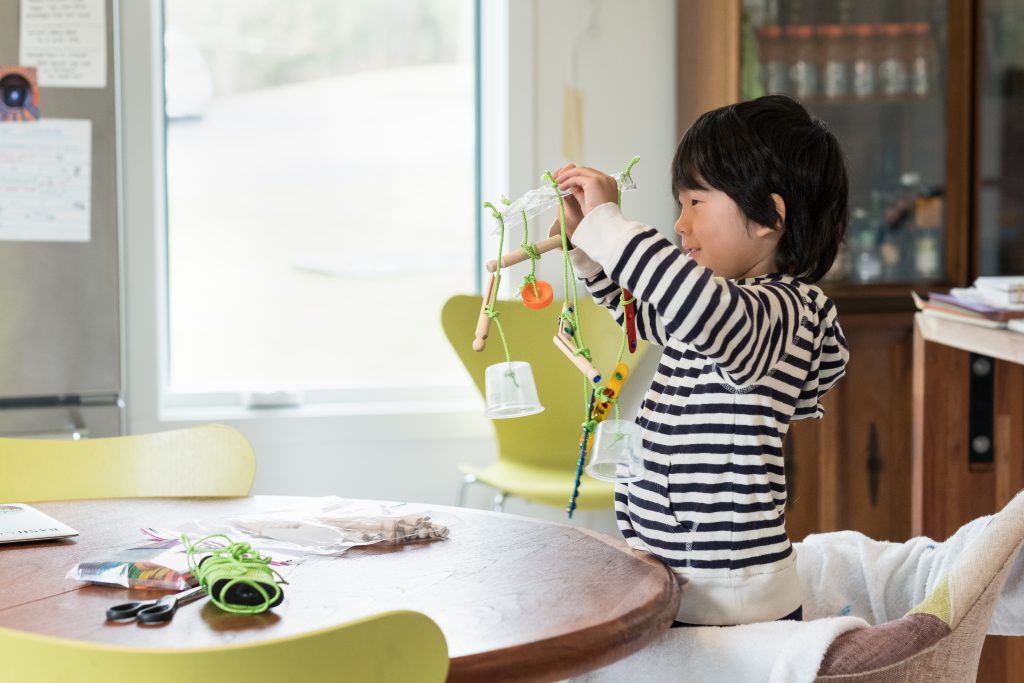

Additional Ideas and Resources
- Crafts: Main a rainstick a la SchoolTimeSnippets
- Arts & crafts: Make a windsock from old toilet paper tubes via IHeartCraftyThings
- Art: Make a rainbow from a paper plate using paint / tissue paper / construction paper like Lavendelblog
- Art: Make a magic rainbow from MessyLittleMonster
Day 3: Plants and Flowers
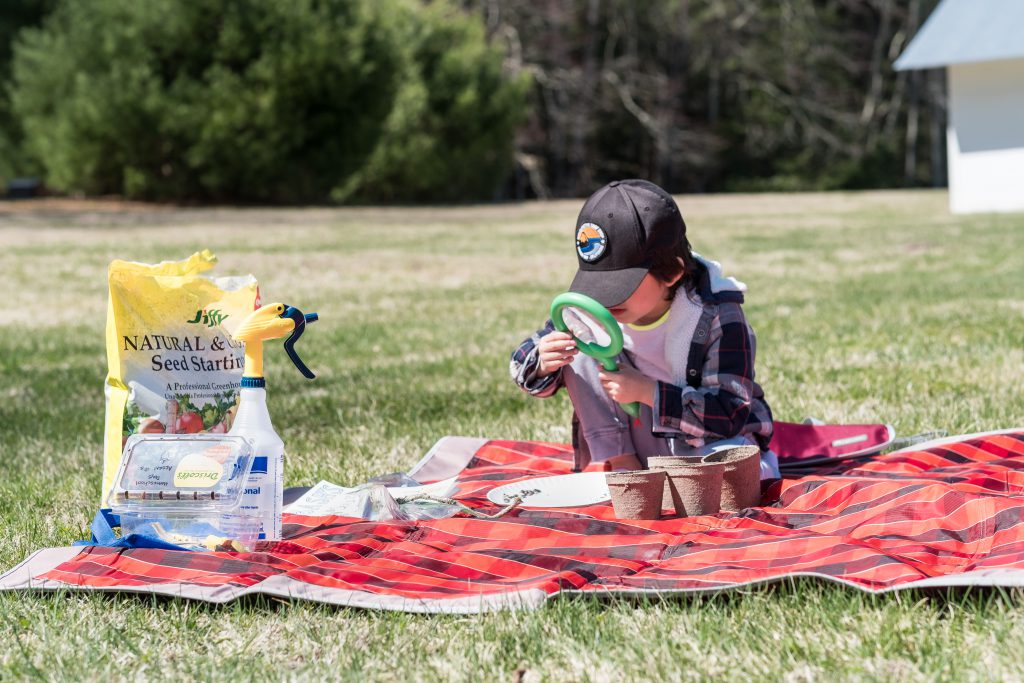
Spring is a time of new growth, so we got our hands dirty and got to digging and planting!
Videos
- Mystery Science How Do Flowers Bloom: A ~5 minute video on how plants move without muscles.
- Mystery Science How Do Plants Grow: Another great video and hands-on experiment to learn what plants need to grow.
- Brain Pop Junior Plant Lifecycle: ~3 minute video providing a simple introduction to the plant lifecycle.
- Brain Pop Junior Parts of a Plant: ~4 minute video covering plant part vocabulary.
- SciShow Kids How Does a Seed Become a Plant: ~4 minute video similar to the Mystery Science How Do Plants Grow topic.
- SciShow Kids Grow Your Own Plants: ~5 minute quick video walking you through an experiment about growing conditions.
- SciShow Kids Look Inside a Flower: ~4 minute video covering flower part vocabulary.
- PBS Kids: From Seed to Fruit: ~2 minute video covering the growth of a cherry tomato plant.
- PBS Kids: From Seed to Flower: ~1 minute video showing time-lapse videos of plants blooming.
Songs
- The Kiboomers The Farmer Plants the Seeds: ~2 minute animated music video set to the tune of The Farmer in the Dell.
Books
- Free video books from Scholastic: Planting a Rainbow (video story) and It Could Still Be a Flower (read along)
- The Tiny Seed (video story from Scholastic)
- Seed to Plant
- How a Seed Grows
- Lola Plants a Garden
- Up in the Garden and Down in the Dirt
- The Carrot Seed
Activities
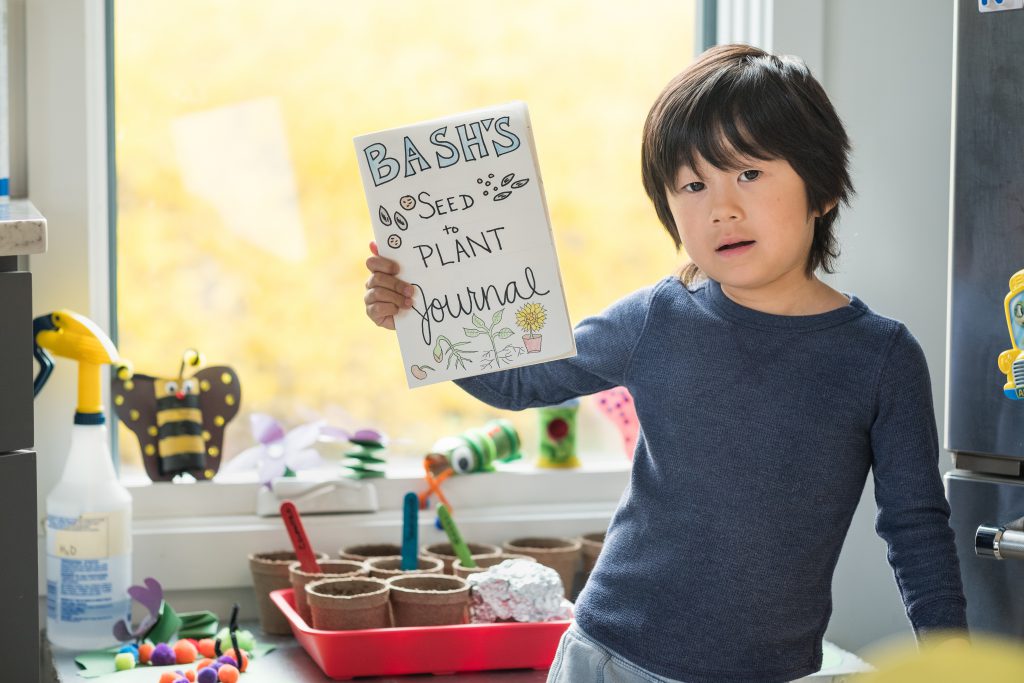
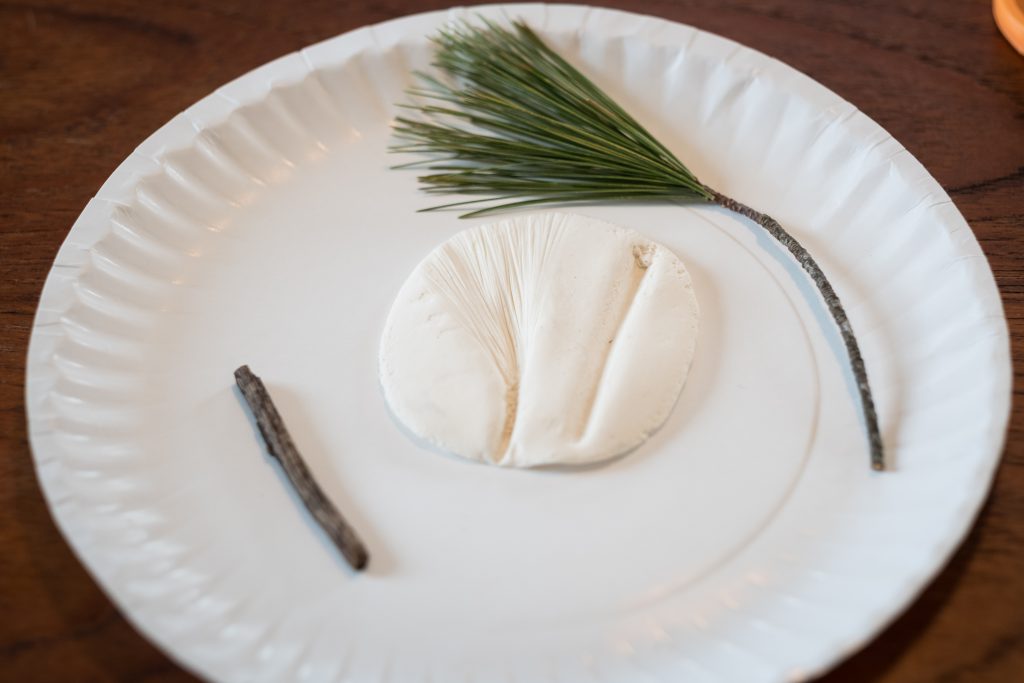
- STEM: Identifying and planting seeds. We’ve grown an indoor garden every spring in our NYC apartment. This year, we planted cilantro, basil, and sunflowers. We examined seeds, reviewed the plant lifecycle, discussed the symbiotic relationship between people and plants, and are keeping a daily journal of our observations. For our detailed list of activities, check out my Indoor Gardening post.
- Art: Leaf rubbings and impressions. Using our various nature items, we made impressions in some modeling clay. We also did a few leaf rubbings on paper as well.
- Art: Toilet paper tube flower prints: We cut the bottoms of old toilet paper / paper towel tubes, dipped them in paint, and made various flower shapes. We left one TP roll intact and slightly bent, cut one with straight lines to make fringe, and another in triangle petal shape. Bash also decided to decorate the prints further with markers, paint, and do-a-dot markers.
- Art: “Spring” flowers from PBS Kids. These flowers on “springy” stems were super fun and easy to make. All you need is construction paper, scissors, glue, and a pen. The only modification we made to the PBS instructions was we glued the green stem base (just the first and last folds) for extra help.
- Movement: Take a walk and spot cherry blossoms, apple blossoms, new spring growth. Try to identify all the plants and flowers.
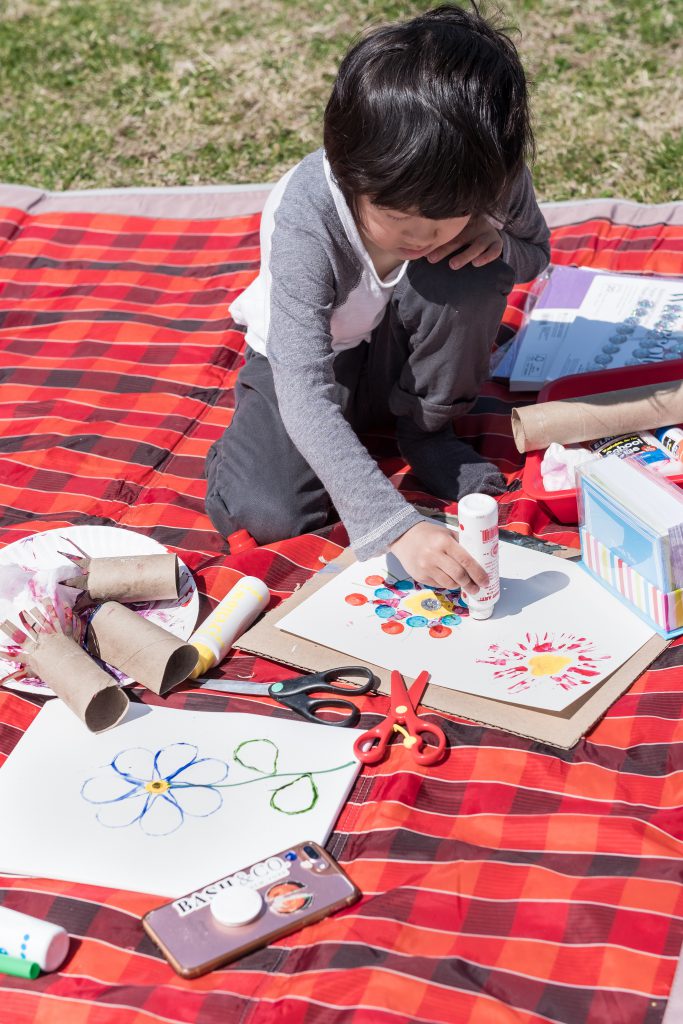
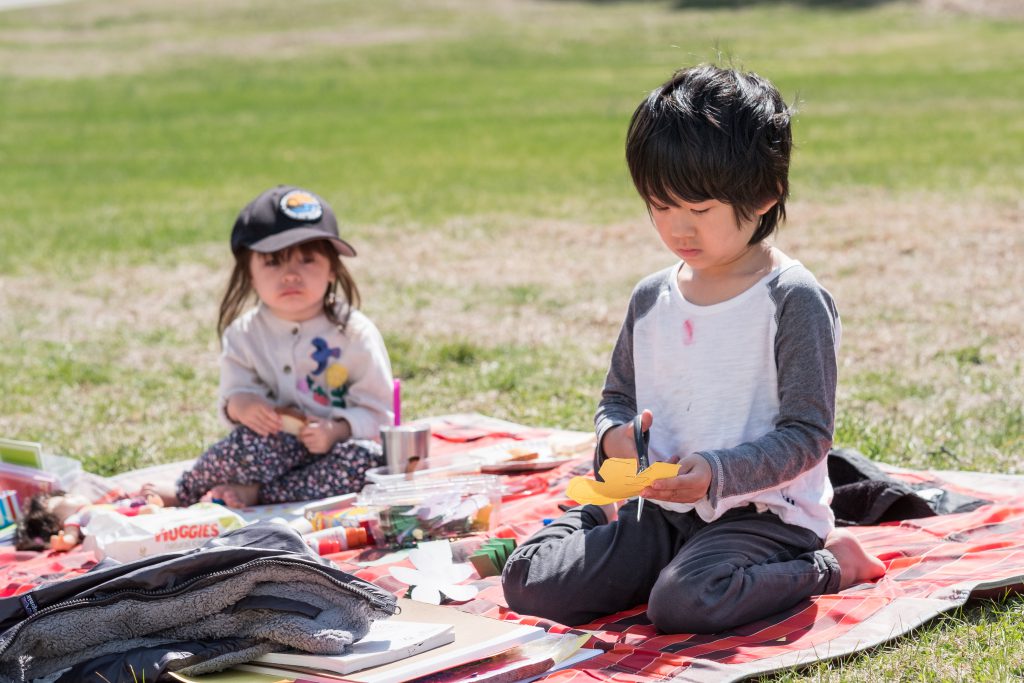
Additional Ideas and Resources
- PBS Kids Plant Life Cycles Lesson Plan: detailed discussion questions and additional activities
- Art project: Paper plate tulips
- STEM: Identify parts of a flower
- Scholastic’s World’s Wildest Plants lesson plan including videos
Day 4: Animal Life Cycle and Migrations

Spring is when animals become active again after the winter. They begin to nest and to reproduce. We’ve been noticing some baby deer and more wildlife in the woods near the yard, so we dove into animal habits in the spring.
Videos
- Mystery Doug: Why Do Animals Come Back in the Spring: ~5 minute video on animal habits.
- SciShow Kids: Big Animal Trips: ~4 minute video on animal migrations.
- PBS American Spring Live: Episode 2 Migration: 1 hour video covering a variety of animals’ migration journeys and the science behind the trips. While a longer show, Bash enjoyed the variety of species covered and the up close photos of real, live animals.
- Mystery Doug Why Do Birds Lay Eggs in the Spring: ~5 minute video focused on birds.
- Brain Pop Jr: Migration: ~4 minute Annie and Moby animated video on animal migrations.
Books
- Free video books from Scholastic: Is Your Mama a Llama (video story) and Animal Babies (read along)
- Brightly’s Home for a Bunny: read aloud
- Free video books from Scholastic: Rosie’s Walk (video story) and A Chick Grows Up (read along)
- Robins: How They Grow Up
- Every Day Birds
- National Geographic Kids: Amazing Animal Journeys
Activities
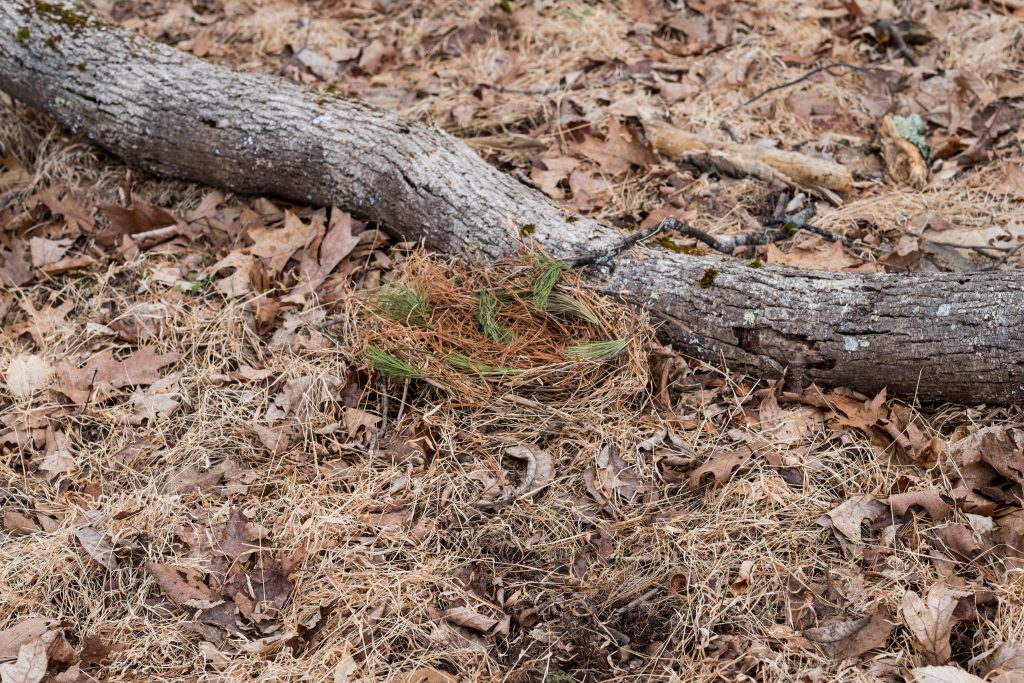
- STEM: Make animal habitats and / or a bird’s nest using items found in nature or upcycled materials. We found a bird’s nest that was recently knocked down by the wind. We spent some time examining the nest to see the kinds of natural materials the birds use for their homes. Using items from our nature walks, we carried home sticks, twigs, grasses, and pine needles and tried our hand at making a nest. For an indoor version, check out tutorials by MamasHappyHive and LittleWorldsBigAdventures.
- Arts & Crafts: Paint a birdhouse. We painted this little wooden birdhouse we had lying around from an earlier craft project. The American Museum of Natural History has a great DIY birdhouse tutorial using a milk juice carton / plastic bottle. PBS Kids also has a simple video guiding you through making a birdhouse and a birdfeeder out of toilet paper tubes
- STEM: Conduct a birdwatching experiment by observing the number and type of birds seen in a 20 minute period of time. Identify, count, and chart the number and type of birds observed and make a graph. PBS Kids has a nice interactive guide to common backyard birds. This PBS Kids ~2 minute video also provides a simple introduction to common birds.

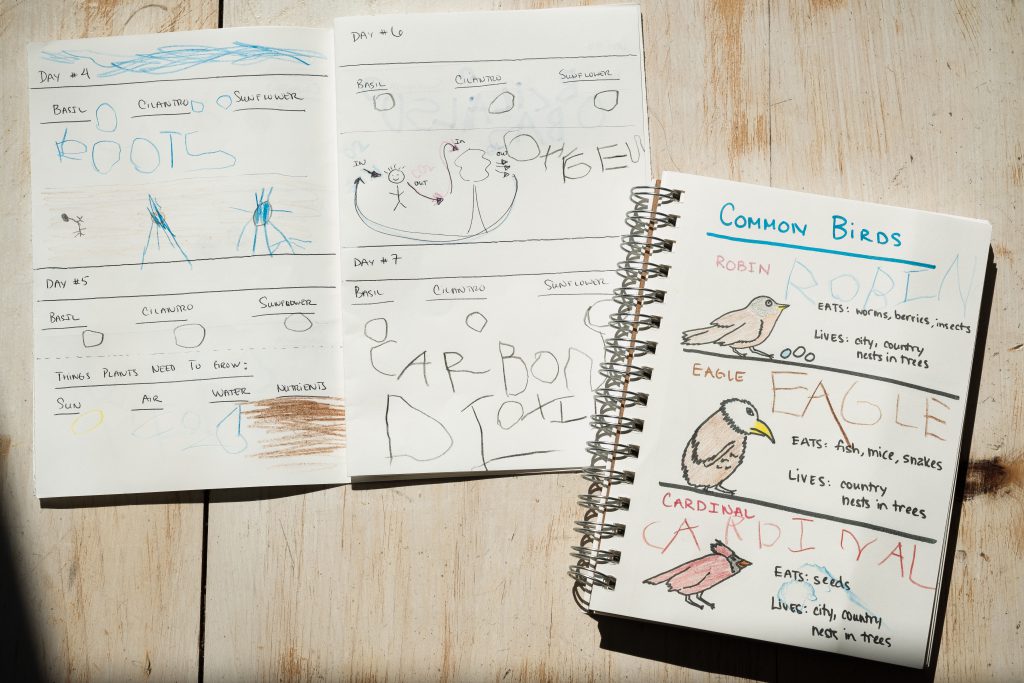
Additional Ideas and Resources
- We have a family of bald eagles living across the street from us, so the kids are very excited and into eagles. They love to spot the eagles flying through the woods and we spent a lot of time learning more about them. Here are some of their favorites:
- All About Bald Eagles for Kids by FreeSchool (~2 minutes)
- Bald Eagles Live From Yellowstone (~2 minutes)
- Eagles – Hunters of the Sky (~30 minute documentary)
Day 5: Insects
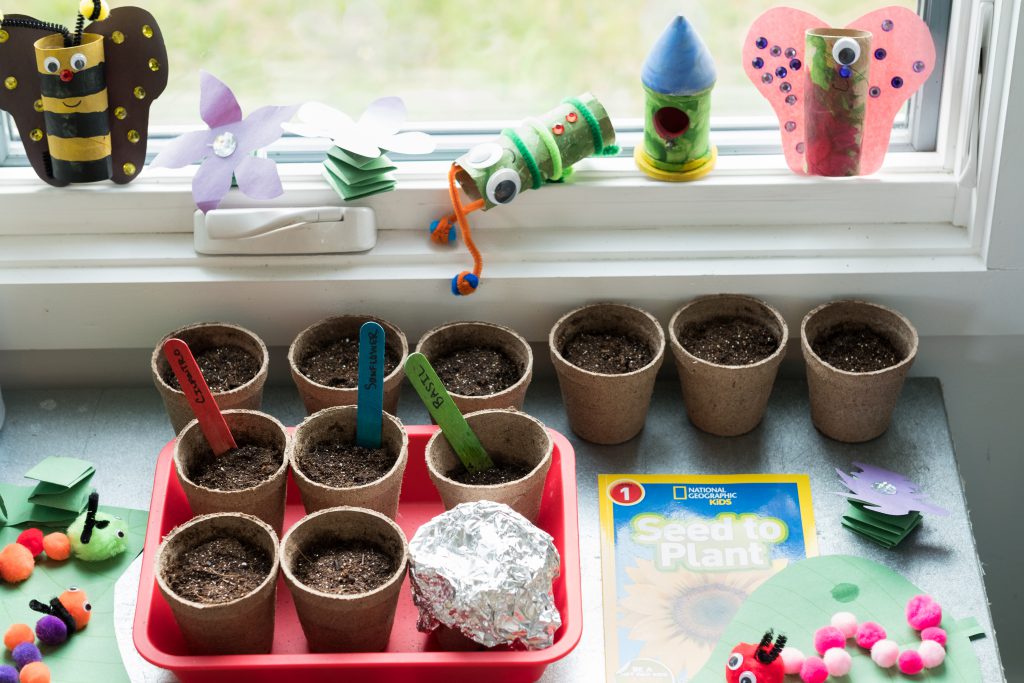
Why are insects so fascinating to kids? Even Ava has jumped on Bash’s bandwagon and loves to hunt for bugs. We’ve been seeing a ton of ladybugs and caterpillars lately, so we decided to take a closer look at a few harbingers of spring.
Videos
- Brain Pop Junior Butterflies: ~4 minute introduction to butterflies and their lifecycle.
- Brain Pop Junior Insects: ~5 minute overview of insects in general.
- SciShow Kids: How a Caterpillar Becomes a Butterfly: ~4 minute introduction to caterpillars.
- SciShow Kids: Inspect an Insect: A ~4 minute video similar to the Brain Pop overview of insects.
- SciShow Kids: Busy Bees: ~4 minute overview of bees and their jobs, but I still had to Google “where do bees go in the winter”
- National Geographic How Do Honeybees Get Their Jobs: A ~3 minute more technical video about honeybees that shares a lot of interesting facts.
- Learn Ladybug Facts for Kids with Tea Time with Tayla: A ~3 minute video sharing a few fun facts in a more cutesy vibe and gets kids counting spots on ladybugs.
- American Museum of Natural History The Butterfly Lifecycle: A short, 1 minute animated overview of the butterfly lifecycle is a good reinforcement to the SciShow Kids caterpillar to butterfly video.
Songs
- Kiboomers Ladybugs: A ~1 minute song about ladybugs to the tun of 3 Blind Mice
Books
- Free video books from Scholastic: Bugs Bugs Bugs (video story) and A Ladybug Larva Grows Up (read along)
- Free video books from Scholastic: Waiting for Wings (video story) and Butterflies (read along)
- Brightly Storytime: The Very Hungry Caterpillar (read aloud)
- Storyline Online: Please Please the Bees (read aloud by Rashida Jones)
- The Honeybee
- National Geographic Kids: Caterpillar to Butterfly
Activities
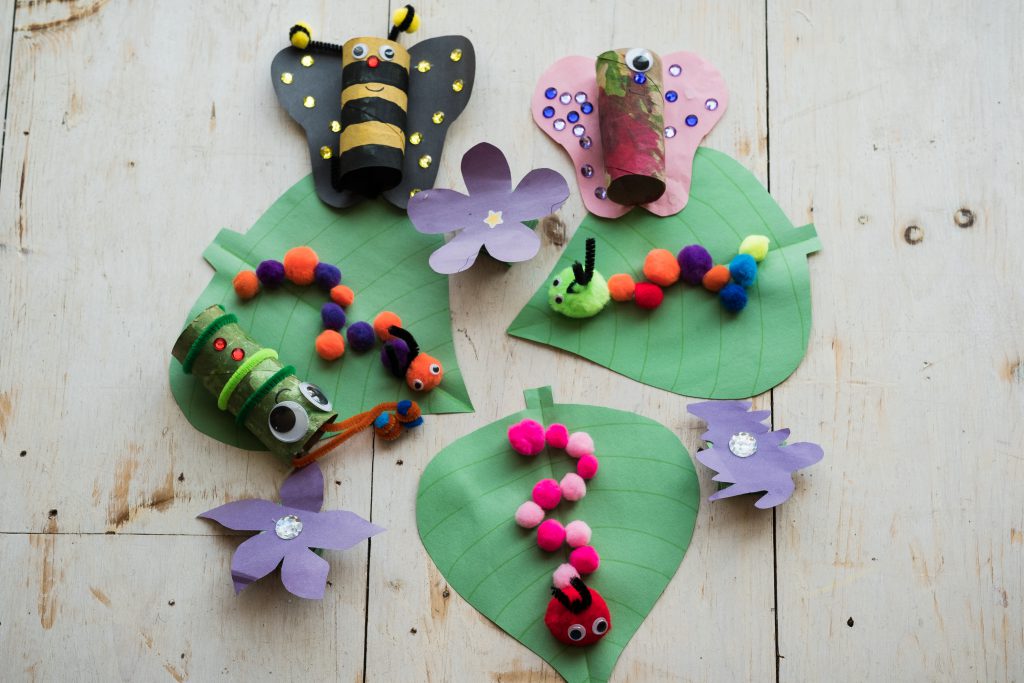
- Movement: Cosmic Kids Yoga: Coco the Butterfly
- Arts & crafts: Create butterflies, caterpillars, and bees from upcycled toilet paper tubes. Just paint the tubes and once dry, go to town with googley eyes, pipe cleaners, construction paper wings, etc. to decorate your creatures. PBS Kids has another fun way to great a butterfly from a toilet paper tube.
- Arts & crafts: Pom pom caterpillars: Cut out a leaf shape from construction paper. Then add glue in an “S” shape to the leaf. Start adding pom poms to build your caterpillar. We used the the pom poms as a fun way to discuss and play with patterns. Then decorate with googley eyes and pipe cleaners.
- Movement: Act out the lifecycle of a butterfly via PBS Kids
- Arts & Crafts and Math: Feed the Caterpillar Activity: Once you’ve made your toilet paper tube caterpillar, add some dice for this fun game.
- STEM: Watch caterpillars transform into butterflies with the Insect Lore Butterfly Garden Kit. We used this kit last year to grow caterpillars and then released the butterflies to Central Park. Bash loved this activity and we probably kept the butterflies for a little too long, as I found hundreds of eggs on the bottom of the mesh container one day!

Share Your Comments: